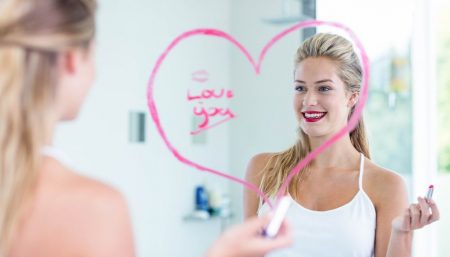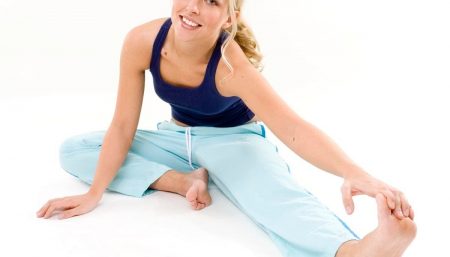Regular practice of yoga, promotes the mind-body connection and is potentially successful way for girls to develop a positive body image. This connection not only improves body image but also promotes better posture and alleviates stress.
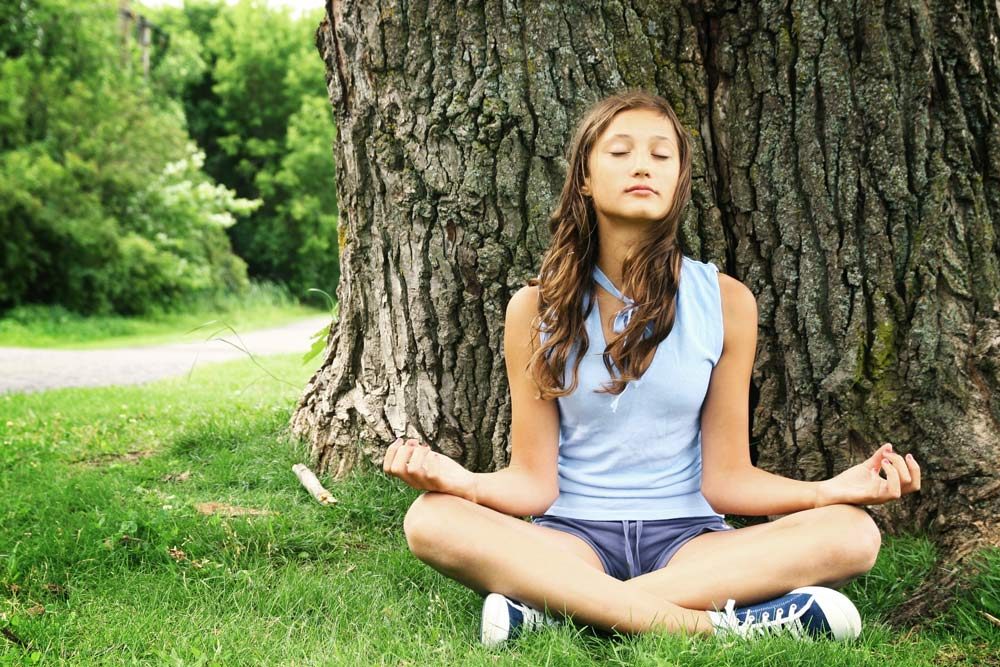
Teenage girls’ are insecure about their bodies and this is quiet apparent through their thoughts about food. Most girls falling within the healthy weight range, do not believe their weight is appropriate and constantly worry about gaining weight or becoming fat. Teenage years are full of changes and stress. With increasing expectations and added responsibilities teenagers feel down from time to time, but if your blues last more than few weeks you may have a disorder called Depression.
These growth turmoil’s are common among teenage girls, but can be treated permanently through, yoga.
Yoga Benefits for Teenagers
- Enhanced Flexibility.
- Good Postural Development.
- Enhanced Self image.
- Reliever from daily stress.
- Resistance against ailments like, asthma and diabetes.
- Weight Maintenance.
- A preventive role in adolescent mental health.
- Rejuvenation
Yoga Poses for Teens
Here are seven poses recommended by yoga professionals who work with teens:
Tadasana Samasthith (mountain pose)
This pose is the starting point of all standing asanas, lifts the sternum, which is the site of the anahata or “heart” charka. This helps to reduce stress and boost your self-confidence, while the perfect balance of the final pose increases your alertness. In Sanskrit, tadasana means “mountain pose” while samasthithi indicates an “upright and steady state.”
- Stand in your bare feet on a smooth and even surface. Keep your feet together, with your heels touching the wall. Beginners may find it easier to keep their feet 5cm (2in) apart.
- Stretch your arms along your sides, with the palms facing your thighs, and your fingers pointing to the floor. Stretch your neck upward, keeping the muscles soft and passive.
- Distribute your weight evenly on the inner and outer edges of your feet, and on your toes and heels. Tighten your kneecaps and open the back of each knee. Turn in the front of your thighs. Tighten your buttocks. Pull in your lower abdomen, and lift your chest.
- Keep your head erect and look straight ahead. Breathe evenly and with awareness. Experience your body and mind as an integrated whole and feel the surge of energy. Stay in the pose for 30-60 seconds.
Adho Mukha Svanasana (Downward Facing Dog)
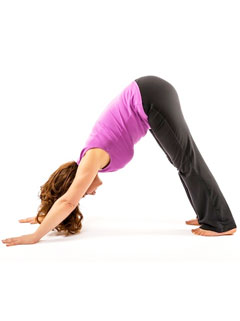 Begin on your hands and knees. Your wrists should be underneath your shoulders, and your knees underneath your hips.
Begin on your hands and knees. Your wrists should be underneath your shoulders, and your knees underneath your hips.- Inhale as you tuck your toes under your heels. Then exhale to lift your hips, coming into an upside down “V” shape called Downward Facing Dog.
- Spread your fingers wide and create a straight line between your middle fingers and elbows. Work on straightening your legs and lowering your heels toward the ground. Your heels should be slightly wider than your toes, so the outside edges of your feet are parallel with the outside edges of your mat. Relax your head between your arms, and direct your gaze through your legs or up toward your belly button. Work on holding for five breaths.
Plank Pose
- Start in Adho Mukha Svanasana. Then inhale and draw your torso forward until the arms are perpendicular to the floor and the shoulders directly over the wrists, torso parallel to the floor.
- Press your outer arms inward and firm the bases of your index fingers into the floor. Firm your shoulder blades against your back, then spread them away from the spine. Also spread your collarbones away from the sternum.
- Press your front thighs up toward the ceiling, but resist your tailbone toward the floor as you lengthen it toward the heels. Lift the base of the skull away from the back of the neck and look straight down at the floor, keeping the throat and eyes soft.
- Plank Pose is one of the positions in the traditional Sun Salutation sequence. You can also perform this pose by itself and stay anywhere from 30 seconds to 1 minute.
Virabhadra (warrior pose I)
This challenging pose strengthens the entire body while improving mental capacity and self control.
- Stand tall with your feet together and arms by your sides. Separate your feet 4 to 5 feet apart, keeping them parallel. Inhale and lift your arms up overhead shoulder-width apart, palms facing each other.
- Exhale and turn your right foot and leg 90 degrees out to the right. Turn your left foot in, toward the right, at a 45-degree angle. Rotate your hips and torso to face the same direction as your right leg. Chances are your left hip will not be completely forward. That’s the beauty of this pose: Squaring both hips so they face the wall in front of you may seem like it takes a few lifetimes, but when it happens, you will have greatly increased your flexibility.
- Take a deep breath. As you exhale, bend your right knee so your right thigh and shin form a right angle. Less than 90 degrees is okay; bend your knee as far as you can while keeping the outer edges of your back foot pressing flat into the floor. Don’t collapse in your back ankle; try to pull up through your left arch (the ankle stays on the ground) to protect that left knee joint. To align your spine, focus on drawing your ribs in toward your body, pressing your tailbone toward the floor, and elongating the back of your neck. Hold for 3 to 10 slow, deep breaths—about an 8-second inhale and 8-second exhale, both through the nose.
- To come out of the pose, lower your arms, straighten your right knee, and return your feet to their starting position. Repeat on the left. Do each side three times.
Virabhadra (warrior II)
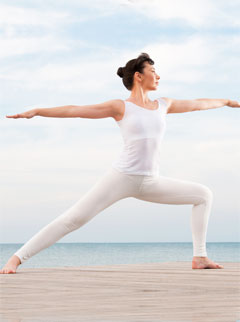 Stand tall with your feet together and arms by your sides. Separate your feet 4 to 5 feet apart and raise your arms out to your sides, shoulder height, palms facing down.
Stand tall with your feet together and arms by your sides. Separate your feet 4 to 5 feet apart and raise your arms out to your sides, shoulder height, palms facing down.- Turn your right foot and leg 90 degrees out to the right and your left foot in about 15 to 30 degrees. (Notice that your left foot turns in less than it did in Warrior I. This protects your hips, which will be rotating differently than they did in the previous pose.) Inhale. As you exhale bend your right knee as much as 90 degrees, keeping your knee stacked above your heel. To further protect the knee, center it over the middle of your foot.
- Turn your face to the right and gaze over your right hand. No limp spaghetti here: Keep your arms strong, shoulders pressing down, creating energy from the tips of your left fingers through the tips of your right. Be aware of what’s happening in your face. Are you squinching? Release any tension in your mouth and jaw. Hold for 3 to 10 slow, deep breaths.
- To come out of the pose, lower your arms, straighten your right knee, and return your feet to the starting position. Repeat on the left. Do each side three times.
Supta Baddhakonasana (cobbler pose):
- Sit in Dandasana. Place a bolster behind you, its short end against your buttocks, and place a folded blanket on its far end. Place 2 wooden blocks on their broad sides on either side of your hips. Bend your knees, and join the soles of your feet together. Draw your heels toward your groin. Buckle the belt and loop it over your shoulders.
- Bring the belt down to below your waist. Pass it under both feet to stretch it over your ankles and the insides of the thighs. Move your feet closer to your groin. The belt should feel neither too tight nor too slack, so adjust the buckle accordingly. Make sure that the end of the bolster touches your buttocks. Position a block under each thigh.
- Place your elbows on the floor, and lower your head and back onto the bolster. Make sure that the bolster comfortably supports the length of your back and your head. Your spine should be on the centre of the bolster. Stretch your arms out to the sides, with the palms facing the ceiling. Relax, and extend your groin out to the sides. Feel the expansion of the pelvis, and the release of tension in your ankles and knees. Initially, With practice, increase the duration to 5 – 10 minutes.
Uttanasana (Standing Forward Bend)
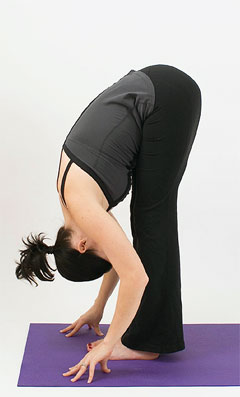 Stand in Tadasana, hands on hips. Exhale and bend forward from the hip joints, not from the waist. As you descend draw the front torso out of the groins and open the space between the pubis and top sternum. As in all the forward bends, the emphasis is on lengthening the front torso as you move more fully into the position.
Stand in Tadasana, hands on hips. Exhale and bend forward from the hip joints, not from the waist. As you descend draw the front torso out of the groins and open the space between the pubis and top sternum. As in all the forward bends, the emphasis is on lengthening the front torso as you move more fully into the position.- If possible, with your knees straight, bring your palms or finger tips to the floor slightly in front of or beside your feet, or bring your palms to the backs of your ankles. If this isn’t possible, cross your forearms and hold your elbows. Press the heels firmly into the floor and lift the sitting bones toward the ceiling. Turn the top thighs slightly inward.
- With each inhalation in the pose, lift and lengthen the front torso just slightly; with each exhalation release a little more fully into the forward bend. In this way the torso oscillates almost imperceptibly with the breath. Let your head hang from the root of the neck, which is deep in the upper back, between the shoulder blades.
- Uttanasana can be used as a resting position between the standing poses. Stay in the pose for 30 seconds to 1 minute. It can also be practiced as a pose in itself.
- Don’t roll the spine to come up. Instead bring your hands back onto your hips and reaffirm the length of the front torso. Then press your tailbone down and into the pelvis and come up on an inhalation with a long front torso.
Note: Always talk to a physician before starting yoga.
Disclaimer
The Content is not intended to be a substitute for professional medical advice, diagnosis, or treatment. Always seek the advice of your physician or other qualified health provider with any questions you may have regarding a medical condition.
